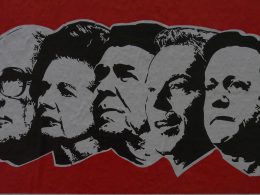The Spirit Level – now available in paperback – argues that inequality of wealth and income are the biggest determinants of social wellbeing and quality of life. socialistparty.net reviews this work which, in many ways, makes the case for socialism.
“It is a remarkable paradox”, write Richard Wilkinson and Kate Pickett, “that, at the pinnacle of human material and technical achievement, we find ourselves anxiety-ridden, prone to depression, worried about how others see us, unsure of our friendships, driven to consume and with little or no community life”. The Spirit Level provides a wealth of well-researched information in support of something socialists know: that inequality is bad for society, as well as individuals. Its facts and arguments are a valuable resource. The book’s central point is that a wide range of health and social indicators and problems are worse in more unequal societies.
For most of history, and in many poor countries today, raising material living standards was and is the best way to improve the quality of life. But recently, in the more prosperous countries, economic growth and higher average income has not increased happiness, wellbeing or the quality of life for the vast majority of the population. In many countries, economic growth in the last few decades has gone hand-in-hand with growing inequality. The authors present a powerful case that the key detriment to health and wellbeing among the richer countries is not the wealth of the country but its degree of inequality.
The authors examine data – from recognised, fully referenced official sources from 1999 to 2003 – for many health and social issues. These include life expectancy, infant mortality, child wellbeing, levels of trust, women’s status, mental illness, illegal drug use, child and adult obesity, educational attainment, teenage birth rates, innovation, homicides, imprisonment, social mobility, working hours and recycling. These are compared for 23 countries with the highest levels of average income per person, ranging from the US and Norway as the richest (around $37,000/person) and Portugal as the poorest (around $18,000/person).
The most unequal countries are Singapore, the US, UK and Portugal. The most equal are Japan and the four Scandinavian countries – although the rapid introduction of neo-liberal policies by successive governments have undermined many past social gains. The authors also compare the 50 states of the US. There was no evidence that the countries with higher income did better. In fact, for many indicators of wellbeing, the US, which is one of the world’s richest countries but also one of the most unequal, came out near the bottom. In contrast, when the same indictors are compared for each country’s level of inequality there is a strong correlation, with the more unequal countries having lower standards of health and social wellbeing, regardless of the country’s wealth.
A wealth of evidence
Wilkinson and Pickett discuss their findings for each of the indicators, outlining other research on the subject and explaining why greater inequality has a negative impact. To give some examples, mental illness is three times higher in the US than Japan, and the UK has a rate twice that of Germany or Belgium (both with lower inequality). Obesity is ten times higher in the US than in Japan and three times higher than in Norway and Sweden – the UK’s rate is seven times and double respectively. The US has a teenage birth rate at least five times that of Japan, Sweden and Finland, while the UK’s rate is at least three times higher.
There are some social and health issues, such as breast and prostate cancer, and alcohol use (rather than abuse), which are not related to social status so that there is no social gradient and, therefore, social inequality has no measurable impact. But for a wide range of social and health indicators, time and again there is a strong relation between lower inequality and better outcomes and little or no relation between average income and outcomes.
A glaring example of the wrong approach is over crime. More unequal societies tend to have higher crime rates and have much higher rates of imprisonment. In the US, a policy of being ‘tough on crime’ began in the late 1970s, with the prison population growing fourfold from 450,000 in 1978 to over two million in 2005. Britain’s prison population doubled between 1990 and 2007. Yet in other countries, including Sweden, Finland, Denmark and Japan, the prison population has hardly changed over recent decades. Most of the increase is due to more and longer prison sentences, not an increase in crime. In 2004 in California, 360 people were serving life sentences for shoplifting. The US rate of imprisonment, as a proportion of the population, is 14 times higher than Japan’s. Japan mostly imprisons people who have committed serious crimes, yet it has a reoffending rate nearly half that of the US.
One part of the ‘American dream’ is social mobility: anyone can make it through their own effort. Yet the US has the lowest social mobility, as measured by comparing the income of fathers and sons, of the countries considered, with the UK second worst. Mobility in the US increased until the 1980s and then decreased as income inequality grew dramatically. As societies became more unequal in recent decades, social problems increased. This shift was particularly rapid and far-reaching in the US and UK with other countries following along.
Health and social problems increase in more unequal countries not only because the poor drag down the average. The authors show that even the well-off do worse in more unequal societies. The literacy achievement of children, whatever the educational level of their parents, ranging from not finishing school to having a university degree, is better the less unequal the society, with Finland near the top and the US near the bottom. Death and infant mortality rates in Sweden are lower than in England for each social class, even the highest. Levels of mental illness are five times higher across the whole population in the more unequal societies. Of course, the poorest benefit most from more equal societies, but all but the super-rich suffer from the effects of inequality.
Other possible causes
Wilkinson and Pickett consider a number of possible explanations other than inequality for the patterns. They look at cultural differences and similarities but these factors do not provide an explanation. Spain and Portugal are culturally similar, both even ruled by dictators until the mid-1970s. Yet Portugal is a more unequal society and fares worse on most measurements than Spain. Japan and Sweden have very different cultures and histories but are among the most equal. They even achieve their relative equality differently. Sweden has relatively progressive tax and public spending policies to narrow the initial income differences. Japan, on the other hand, has relatively narrow income differences with government tax and spending having little redistributive impact. In spite of the different roads to relative equality the social outcomes are similar with Japan and Sweden either being best or nearly best on most measurements.
Another common explanation for poor performance on the many measurements is the breakdown of the family – how often do politicians talk about ‘family values’? – resulting in many single parent families. Usually children of single parent families do less well than those from two parent families. But what are the causes? The authors present a graph comparing child wellbeing with the proportion of single parent families in society. There is no correlation. There is, however, a strong link between child wellbeing and society’s level of inequality.
One of the striking thoughts in the book, obvious but seldom considered by politicians, is that our societies treat each problem separately, tackling symptoms rather that causes. Quite large sums of money and much time are spent treating poor health, mental illness, crime, or children struggling at school. Yet these programmes usually have limited benefit. They may help some individuals but do not tackle the causes so the problems are constantly recreated. The book argues, with good evidence, that tackling inequality would be a more effective response as it would tackle the roots of many problems.
Divisive and corrosive
Humans are social beings. We depend on society to exist and have a high awareness of social relations. In more unequal societies people are more concerned about status and more insecure. The greater the inequality the more status matters as people try to keep up appearances. Perceptions of status affect behaviour.
Wilkinson and Pickett refer to experiments testing children from different social backgrounds in India and the US. When the children were unaware of each others’ status, those from a lower caste in India did better than upper caste children. When their caste was announced beforehand, the lower caste children did worse. In the US, groups of black and white children were given tests. In one, they were told that the test was of ability, in the other, that it was not. The white children did the same in both cases, but the black children had worse results if told they were being tested for ability.
In an even starker example, school children were told blue eyes were linked to higher intelligence. Subsequently, those with blue eyes rapidly out-performed the other children and acted superior to them. The brown-eyed children became timid and their marks declined. After some time, the teacher said she had got it wrong and that brown eyes were linked to intelligence. Soon the roles and performance in the class were reversed.
Also, in a more unequal society if things go wrong, such as job loss, failure to do well at education, serious injury, long-term illness, or household break-up, the distance to fall is greater with more suffering. So in more unequal societies there is more stress and insecurity. Even for those doing reasonably well there is concern about the future.
Among the responses to concern about status is a trend to talk oneself up and to try to look good. People in unequal societies often appear to have high self esteem. However, this is fragile and linked to insensitivity to others. It is often called ‘threatened egotism’ or ‘narcissism’. Modern advertising (a $1 trillion-a-year business) exploits concerns about status to sell goods. Most ads are about how the product will make you feel good and seem better in some way, encouraging so-called ‘shopping therapy’. But it does not make a person happy, more loved or whatever, so the treadmill of buying continues. Insecurity encourages excessive consumerism – buying things to look good and ‘keep up with (or in front of) the Joneses’ – rather than buying goods to meet needs or find satisfaction.
There is strong evidence that people have a deep sense of fairness which an unequal society offends. In an unequal society, people feel excluded or fear being excluded. It is harder to form and maintain strong friendships and a sense of community. Inequality is divisive and corrosive of societal and individual wellbeing. The stress and anxiety of individuals in unequal societies are passed on to children even before birth. The chemicals of stress in the mother’s blood are passed to the foetus. Then in early childhood, living in stressed households with anxious and insecure caregivers impacts on a child. Children absorb stress and anxiety both physically and emotionally.
Although Wilkinson and Pickett do not use the word ‘alienation’ in the book, in many ways the concept captures the results of increased inequality – people are more alienated from society, work, other people and themselves. All of this contributes to social ills. Alienation was a key concept for Karl Marx in discussing the negative impacts of capitalism. In recent years it has been less frequently used by Marxists; it is probably time to re-establish alienation as part of our critique of capitalism.
Sustainability and innovation
One of the important points of the book’s discussion of the findings is around sustainability and the environment. Some environmentalists claim the ecological crisis is so great that we have to tackle this without waiting to solve social issues. Some even advocate an eco-dictatorship to save the planet. Yet Wilkinson and Pickett show that greater equality and better social justice is important for environmental action. More equal societies score better on environmental performance. More equal societies have higher levels of trust and cooperation, important qualities to help make the changes needed. The authors point out that environmental actions that are unjust are much less likely to gain widespread support. Social justice is vital to tackle the environmental issues the world faces.
Inequality increases consumerism, the unnecessary purchase of goods in the vain attempt to meet social and emotional needs which cannot be met by things alone. This consumerism feeds the unnecessary consumption, use of resources and production of waste.
One of the more striking findings of the book is about innovation. Right-wing politicians and academics claim that innovation is stimulated by the possibility of personal gain and that this is greater in more unequal societies. Wrong. The authors look at the number of patents in proportion to population. They found that more equal societies do better. Finland, Sweden and Norway have ten times more than the US, Portugal and the UK. A more equal society will be more likely to develop new and appropriate technologies for the environment.
It is still true that billions of people need their living standards raised. Even in the richer countries there is real poverty and most people need to escape from insecurity with an assured good standard of living regardless of whether they are working, retired, healthy, ill, studying or a child. The book’s evidence points out that in the richer countries reducing inequality is an important step. A much more equal society in the richer countries, ending the hugely excessive consumption of the top 10%, and drastic cuts to wasteful spending on advertising and armaments, would improve life for all and provide spare wealth to help the rest of humanity. This, combined with greatly improved technology and full use of renewable energy, could meet the needs of humanity without damaging the environment. Social justice and environmental action need to be combined for a better future for humanity.
Not surprisingly, The Spirit Level has provoked a lot of discussion, much of it favourable, since it was first published in 2009. However, there have also been some strident criticisms from organisations such as the Taxpayers’ Alliance in Britain. The second edition of the book and The Equality Trust website have detailed responses to the critics. Many of the criticisms are deliberate misrepresentations for political reasons to try to undermine the book’s evidence.
One critic, Christopher Snowdon, works for the so-called Democracy Institute, a right-wing think tank, which opposes tax on tobacco while supporting gambling. It also has links to the Cato Institute in the US, noted for its scepticism of climate change and support for the privatisation of public services. Another critic, Peter Saunders, writes for the Policy Exchange, a British Conservative think tank that has advocated massive cuts in public spending and public-sector pay and pensions, further widespread privatisation, attacks on unions and increased university fees. Does this sound familiar? By your enemies are you known!
Political conclusions
Wilkinson and Pickett recognise that to reduce inequality will take a political transformation. It was the political offensive of the right wing in the US and Britain (Reagan and Thatcher) that launched the dramatic increase in inequality which is now hitting every country. The authors also point to the domination of large corporations that shape the world. At times, however, the political conclusions of the book are mixed. Maybe the authors are trying to appear moderate in the hope of getting right-wing politicians to support them. They claim, for example, that a more equal society could spend less on repairing the damage of inequality, such as prisons, healthcare, social benefits, treating mental illness, etc, and so could cut taxes. Of course, this assumes that right-wingers really care about these issues. Class society is run for the benefit of a tiny minority, the very people who do not suffer from an unequal world. They strive to cut and privatise public services and attack trade unions to boost their profits and weaken the ability of working people to fight back.
The authors point out that, for the last few decades, politics and ideology have been dominated by those who embrace greater inequality, using the claim that in a globalised world there is no alternative. However, this has delivered the worst recession in 80 years and most people are less happy and worse off. In contrast to the claims of the right, most people support reducing inequality. A survey in the US found that 92% of people would prefer to live in a society with Sweden’s level of inequality than the USA’s. Wilkinson and Pickett argue that their research shows that many social problems can be reduced. More importantly, the book gives hard evidence to support most peoples’ feeling of revulsion at huge inequality. They write: “Egalitarian sentiments are hidden close to the hearts of vast numbers of people… the culture of the last few decades has reduced us to closet egalitarians: it is time to come out of the woodwork”.
There is a risk that the authors idealise the distribution of wealth of 40 years ago. The reforms that produced the reductions in inequality after the second world war were the result of huge struggles around the world. The authors seem to believe that a more equal society, at least to the levels of the 1960s and 1970s, can be achieved within capitalism. However, this would require a mass mobilisation to reverse the neo-liberal attacks, sustained pressure to prevent a repeat of the onslaught of the last 30 years, and assumes that the capitalist economy will recover enough to afford it.
It would be more beneficial to mobilise to eradicate capitalism, the root cause of inequality and poverty, rather than limiting the struggle to reducing inequality. Also, the authors do not analyse the economic dependence of capitalism on constant growth, both economically and politically, regardless of damage to the environment. The ruling elites, rather than tackling poverty through redistribution – which they do not want – claim that economic growth will lift people out of poverty. This is one of the legitimising myths of capitalism. While some of the political analysis about the nature of capitalism is weak, the book does demolish the false claims of ‘trickle-down’ economics. It provides powerful evidence in support of socialist economic planning and workers’ democracy.












